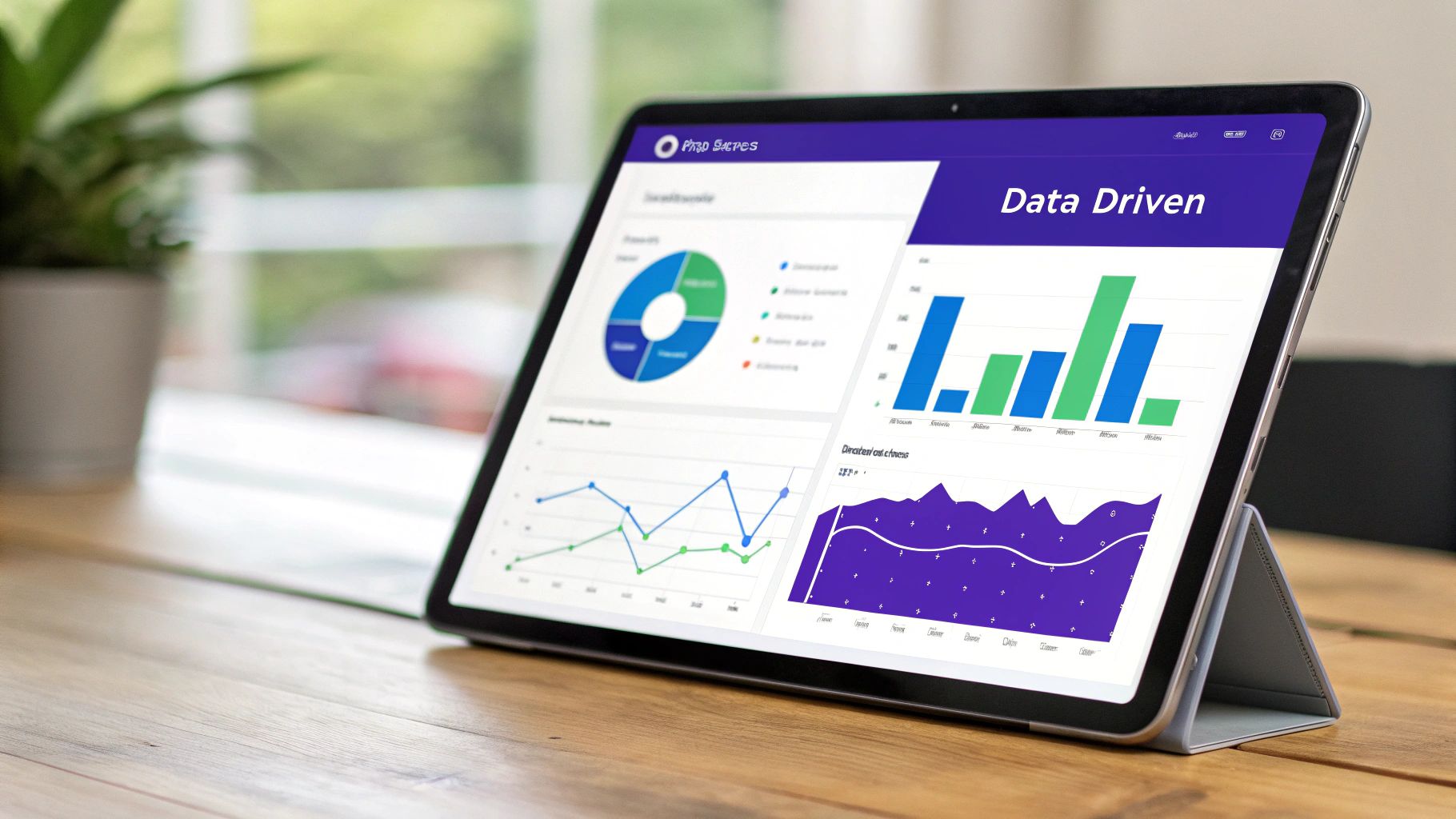Why Shopify Is Your Perfect Digital Product Launchpad
Selling digital products requires a platform tailored to the unique demands of this market. Shopify has emerged as a leading choice for digital entrepreneurs. But what makes it so compelling? This section explores the advantages of using Shopify for your digital product business, highlighting why it's the ideal launchpad.
Secure Delivery and Seamless Payments Build Trust
One of the biggest concerns when selling digital products is secure delivery. Shopify's robust infrastructure offers a safe and reliable method for delivering digital goods, from ebooks and online courses to software. This secure delivery system fosters customer trust, assuring them their purchases will arrive safely and quickly.
Additionally, Shopify offers smooth payment processing, integrating with various payment gateways. This simplifies transactions for both you and your customers, further enhancing the customer experience.
Real-World Success: From Frustration to Flourishing
Many creators have experienced the headaches of trying to sell digital products on platforms not built for that purpose. They’ve encountered clunky interfaces, limited features, and complicated delivery systems. Switching to Shopify, however, often dramatically improves their businesses. Their success stories showcase the platform's effectiveness in smoothing the digital product journey.

The rise of selling digital products on Shopify is significant due to its versatility and user-friendly interface. In 2023, Shopify generated $7 billion in revenue, a substantial increase from $1.5 billion in 2015. This growth underscores its appeal for entrepreneurs selling digital goods. Apps like the Digital Downloads app simplify product listing and sales management without coding. Shopify's global reach, with merchants in over 175 countries, also opens a vast market for digital product sellers. You can find more detailed statistics here: Shopify Statistics. This global presence maximizes your sales potential.
Scalability: From Single Product to Thriving Business
Interested in launching your own digital product? Check out this helpful resource: How to master your digital product launch. Starting small is often the best approach. Shopify lets you begin with a single offering and expand your product line as your business grows. This scalability is a significant advantage, ensuring your platform adapts to your evolving needs.
Whether you start with one ebook and later add online courses, or build a full membership site, Shopify provides the infrastructure to support your expansion. For example, you could start with a basic photography preset pack. Later, you could offer advanced editing tutorials and workshops, building a comprehensive ecosystem of learning resources. This approach boosts your revenue potential while strengthening your brand and customer loyalty, creating opportunities for a thriving online business.
Setting Up Your Digital Products Store That Converts
Building a thriving digital product store on Shopify involves more than just uploading files. It takes careful planning and execution to create a smooth and engaging experience for your customers. This section will guide you through the key setup steps, helping you turn the technical aspects into a real advantage for your online business.
Choosing the Right Shopify Plan
Your Shopify plan is the backbone of your store. Choosing the right one is essential for balancing the features you need with your budget. Each plan comes with different features and transaction fees, which can directly impact your bottom line.
To help you decide, let's take a look at the different plans available. The following table outlines the key features relevant to digital sellers:
Shopify Plans Comparison for Digital Sellers: A comparison of different Shopify subscription plans highlighting the features most relevant to digital product sellers.
| Plan | Price | Transaction Fees | Digital Product Features | Best For |
|---|---|---|---|---|
| Basic Shopify | $29/month | 2.0% | Unlimited | New businesses with basic needs |
| Shopify | $79/month | 1.0% | Unlimited | Growing businesses with higher sales volume |
| Advanced Shopify | $299/month | 0.5% | Unlimited | Established businesses with high sales volume |
All Shopify plans support unlimited digital products. The key difference lies in the transaction fees, which decrease as you upgrade. Consider your expected sales volume. For example, if you project high sales, the Advanced Shopify plan’s lower transaction fees might balance out the higher monthly cost.
Configuring Your Digital Product Delivery
Once you've chosen a plan, setting up a smooth delivery system is crucial. Customers expect instant access after they buy something. Shopify simplifies this by automatically sending download links after a successful purchase.
This automation makes for a happy customer, encouraging repeat business and positive word-of-mouth. Consider also using platforms like Tevello to enhance the delivery process, especially for courses and memberships. It provides more control over access and presents your content professionally.
Crafting Compelling Product Descriptions
With digital products, you need to overcome the fact that customers can’t physically touch them. High-quality product descriptions are key for convincing customers of your digital offerings’ value. Focus on the benefits and the positive changes your product brings, not just the features. Instead of stating "10 Photoshop templates," highlight how these templates will "save you hours of editing and boost your social media presence."
Pricing Your Digital Products Strategically
Pricing for digital products is different than for physical goods. Your main cost is usually the initial development time, not the per-unit production. This allows for flexible pricing strategies. Consider factors like perceived value, competitor pricing, and your target audience. Offering different tiers with varying access levels or support can maximize revenue and cater to different customer needs.
Essential Apps and Legal Considerations
Several apps can streamline your digital product business. Automated delivery apps simplify the sending process, licensing protection tools safeguard your intellectual property, and customer management apps help organize your buyers. It's also important to ensure you have the correct legal measures in place. This includes copyright protection for your work and clear terms of service outlining customer usage rights. These steps protect your business and build trust with your audience.
Digital Products That Actually Sell on Shopify
Selling digital products on Shopify offers a wide range of opportunities, but not all digital products are created equal. This section explores what sells well on the platform, looking at market trends and what makes customers click the "buy" button. This information will help you assess your own skills and find profitable niches.
Profitable Digital Product Categories on Shopify
Some types of digital products consistently do well on Shopify. These often tap into specific needs and wants, leading to high customer demand:
-
Educational Resources: Online courses, workshops, and ebooks that teach valuable skills or share important knowledge are always in demand. These appeal to a broad audience looking to learn something new, improve their career prospects, or explore creative pursuits. A course on photo editing, for example, could attract both hobbyists and professionals.
-
Templates and Tools: Productivity templates, design assets, and software tools offer quick solutions to everyday problems. These are especially valuable for business owners. Think about templates for social media, business plans, or website layouts.
-
Digital Art and Entertainment: This includes stock photos, music, and digital artwork. These appeal to creative individuals and businesses looking to enhance their projects. Limited-edition digital art or exclusive music tracks can often fetch a premium price.
-
Memberships and Communities: Creating a sense of community with membership sites offers exclusive content and networking opportunities. This adds ongoing value. This could be access to a private forum, regular webinars, or downloadable resources focused on a particular niche.
You might find this helpful: How to master selling digital products on Shopify.
Analyzing Successful and Struggling Digital Products
Figuring out why some digital products fly off the virtual shelves while others languish is crucial. Products that offer practical solutions, clear value, and effective marketing tend to perform well. Imagine a user-friendly budgeting spreadsheet that helps people manage their finances more effectively.
Products that lack clear benefits, target a very small niche, or have poor marketing often struggle. A highly specialized technical manual with limited practical use might not see many sales. This highlights the importance of understanding your target audience and emphasizing the practical advantages of your product.

Matching Your Skills to Market Demand
Matching your skills to what the market needs increases your chances of success. Think about your expertise. What problems can you solve? What knowledge can you share? If you’re a talented graphic designer, creating design templates or offering online design courses could be a good fit.
Seek out underserved niches or developing trends within your skillset. This minimizes competition and helps establish you as a leader. Recognizing these emerging trends can give you a real advantage. Perhaps there's a growing interest in eco-conscious design. You could create templates or courses specifically for this market.
Emerging Digital Product Categories
Staying ahead of the curve by exploring new digital product categories can give you a competitive edge. Areas like personalized coaching, interactive virtual experiences, and highly specialized educational content are gaining traction. Being an early adopter in these areas often translates to higher conversion rates and less competition. This allows you to build a strong presence in a developing market. For instance, personalized online coaching within a niche market, like business coaching for sustainable fashion brands, could be a profitable strategy. This highlights how combining your skills with emerging trends can lead to profitable digital products.
To help you better understand the potential of various digital product types, let's look at a detailed breakdown:
Digital Product Types by Profit Potential
Analysis of different digital product categories with their relative profit margins, creation difficulty, and market saturation levels
| Product Type | Profit Margin | Creation Complexity | Market Saturation | Audience Reach |
|---|---|---|---|---|
| Online Courses | High | Medium | Medium | Broad |
| Templates & Tools | Medium | Low | Medium | Broad |
| Digital Art & Entertainment | High | Medium | High | Niche to Broad |
| Memberships & Communities | High | High | Low | Niche |
| Personalized Coaching | High | Medium | Low | Niche |
| Interactive Virtual Experiences | Medium | High | Low | Niche to Broad |
| Hyper-Niche Educational Content | High | Medium | Low | Niche |
This table illustrates the potential profitability of different digital products. While some, like online courses and digital art, have broader appeal, their market saturation might be higher. Others, like personalized coaching and hyper-niche educational content, might cater to a smaller audience but offer higher profit potential due to lower competition. Balancing creation complexity, market saturation, and potential audience reach is key to choosing the right product for you.
Marketing Strategies That Move Digital Inventories

Marketing digital products presents unique challenges. Unlike physical goods, customers can't experience them in the same way. This section explores effective strategies for promoting digital products on Shopify.
Content Previews and Samples: Satisfying Curiosity
Offering strategic previews is a powerful marketing technique. Allowing potential buyers to experience a portion of the product builds trust and piques their interest.
For example, offer a free chapter of an ebook or a free introductory video for an online course. This allows customers to assess the product's quality and relevance firsthand.
Email Sequences: Nurturing Digital Buyers
Email marketing remains a highly effective tool. Targeted email sequences can guide potential customers through the buying process.
Start by offering a lead magnet like a free checklist or template to capture email addresses. Then, nurture leads with valuable content related to your product. This builds anticipation and demonstrates its value. A series of emails discussing the benefits of efficient project management, for example, could lead to an offer for your project management software.
Social Media Strategies: Showcasing Intangible Value
Showcasing the value of digital products requires creativity. Use visuals and storytelling on social media to bring your product to life.
Consider behind-the-scenes videos, customer testimonials, or before-and-after examples. If you’re selling photography presets, show their impact with compelling visuals. If you sell a writing course, share inspiring student success stories.
Paid Advertising Tactics for Digital Products
While influencer marketing can be effective for physical products, digital products often benefit from a different paid advertising approach. Focus on targeted campaigns that reach customers actively seeking solutions your product offers.
Highlight the specific problems your product solves and emphasize its unique benefits. Choose platforms where your target audience spends their time. LinkedIn, for instance, might be more effective than Instagram for products targeting business professionals.
Pricing Strategies: Reflecting Value
Pricing digital products hinges on perceived value. Consider offering various pricing tiers with different levels of access or support. You might find this helpful: How to Price Online Courses.
Bundling related products can also increase average order value. Offer a package that includes an ebook, templates, and access to a private community forum, for example. This provides a more comprehensive solution and encourages larger purchases. Selling digital products on Shopify requires strategic marketing. Success stories like generating over $1,000 per month demonstrate the platform’s potential. Shopify Success Story. Using simple store themes and offering bundled packages can significantly boost conversions. The platform’s reliability lets sellers focus on content creation and marketing – essential for staying competitive.
Data-Driven Optimization for Digital Product Success
Selling digital products on Shopify requires more than just setting up your store. To truly succeed, you need to understand how customers interact with your digital offerings and optimize based on data. This section explores data-driven optimization, showing you how to use insights to boost sales and grow your business.
Understanding Customer Behavior With Digital Products
Customer behavior with digital products differs from physical products. Consider factors unique to digital sales, such as browsing duration on product pages, download completion rates, and engagement with preview materials.
For example, if customers consistently abandon a specific course module, it signals a potential issue with that module's content. This data provides valuable feedback for product improvement and increasing customer satisfaction.
Key Conversion Metrics for Digital Products
Focus on conversion metrics relevant to digital products. These might include:
-
Conversion Rate From Product Page to Checkout: A low conversion rate could indicate a problem with your product description, pricing, or checkout process.
-
Cart Abandonment Rate for Digital Products: High abandonment rates might signal technical issues with checkout, unexpected costs, or a lack of trust.
-
Refund Request Rate for Digital Products: Frequent refund requests often point to a mismatch between customer expectations and the actual product. This underscores the importance of accurate product descriptions.
Establishing benchmarks helps you track progress and identify areas for improvement. These benchmarks should be specific to your product category. For example, the average conversion rate for online courses might differ from that of digital art prints.
Split Testing for Continuous Improvement
A/B testing, or split testing, is a powerful technique. It allows you to compare two versions of a webpage or element to determine which performs better. This might include testing different preview content, pricing presentations, or call-to-action buttons.
For instance, testing a shorter, benefit-focused product description against a longer one can reveal which approach resonates better with your audience. Even small changes can significantly impact conversion rates.
Leveraging Shopify Analytics
Shopify offers robust analytics tools to track and optimize digital product sales. The platform allows viewing sales reports by month, channel, or staff, providing insights into sales performance. This is essential for monitoring sales patterns, especially during peak periods like holidays or promotions.
For example, during Black Friday and Cyber Monday in 2022, mobile shopping dominated Shopify sales, accounting for 69% of transactions. By leveraging such analytics, sellers can adjust strategies to increase sales. Explore this topic further: Find more detailed statistics here.
Gathering and Implementing Customer Feedback
Actively seek customer feedback. This helps identify areas for improvement and potential expansion opportunities. Surveys, reviews, and social media interactions provide valuable insights into customer needs.
This information is invaluable for refining products and ensuring they meet market demand. For example, consistent customer requests for a specific feature could indicate an opportunity for a new product. Using feedback to continually improve and expand offerings strategically leads to greater customer satisfaction and increased sales. This iterative process is essential for long-term success.
Scaling Your Digital Product Empire on Shopify

Growing a successful digital product business on Shopify is a multifaceted endeavor. It requires more than simply launching a product; it demands a strategic approach to scaling operations and expanding your reach. This section explores proven methods for growing your digital product empire without a corresponding increase in your daily workload. Once your Shopify store is set up, ongoing optimization is key for driving sales. For additional tips, check out this helpful resource: Increase Sales on Shopify.
Building a Complementary Product Ecosystem
Successful Shopify sellers often cultivate a product ecosystem. This interconnected approach encourages customers to purchase multiple offerings, ultimately increasing customer lifetime value. Think of it as a ladder, with each rung representing a product of increasing value and complexity.
For instance, if you offer a beginner's ebook on graphic design, you could then offer intermediate and advanced courses. This provides a natural progression for customers, encouraging them to return for more and fostering loyalty.
Automating Your Digital Business
Automation is essential for scaling a digital product business. By automating tasks like email marketing with a tool like Klaviyo, customer support, and product delivery, you free up time to focus on product development and other high-level strategic initiatives.
Consider automating email sequences to deliver course materials after purchase or provide helpful product-related tips. This not only streamlines the customer experience but also allows you to reach a larger audience without increasing your workload. Remember, even automated systems should maintain a personal touch.
Strategic Partnerships for Extended Reach
Partnerships can significantly broaden your audience. Affiliate marketing, where others promote your products for a commission, can introduce your offerings to a new customer base.
Collaborations with other creators on joint products or bundles can also expose your brand to a wider audience. For example, a photographer selling presets could partner with a graphic designer offering templates, creating a bundled package appealing to both audiences. This synergistic approach enhances value for customers and expands reach.
International Expansion for Digital Products
Digital products easily transcend geographical boundaries. Selling internationally offers immense growth potential. While you don't need to manage physical shipping, adapting your offerings to different languages and cultures is crucial.
Consider translating product descriptions, website content, and customer support materials. This thoughtful localization will increase your appeal to a global audience and maximize your sales potential.
Growing your digital product business on Shopify requires a well-defined strategy. By building a complementary product ecosystem, automating key processes, forming strategic partnerships, and exploring international expansion, you can efficiently scale your operations. Consider integrating courses and communities directly into your Shopify store using a platform like Tevello to enhance customer engagement and drive sales. This integrated approach streamlines operations and creates a more cohesive customer experience.




